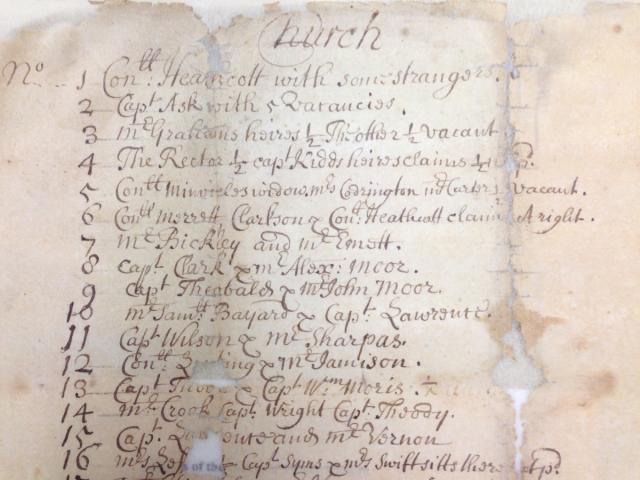Captain Kidd lends Runner & Tackle for Building First Trinity Church
There are many tales and legends that surround the infamous Captain William Kidd. A fascinating and, perhaps, misunderstood character of history, Kidd is often associated with sea piracy and allegedly burying treasure in the Caribbean in the later parts of the 17th century. But Captain Kidd is also sometimes associated with Trinity Church, and for good reason. After all, it was this week, 320 years ago, when Kidd agreed to lend Trinity a hand with the construction of the first Trinity Church building.
William Kidd was, by many accounts, a successful and respected Privateer—that is, a Captain of a private ship that a government could employ to attack foreign vessels during times of war, in part to protect ships of their own and to take enemy vessels and their cargo as prizes. William Kidd was even hired by the English on several occasions to do exactly that kind of work. The Captain would eventually develop the unfavorable reputation of being more pirate than privateer after several reports that Kidd was attacking ships without orders. As the line between pirate and privateer was indeed a blurry one, it may not be surprising that Kidd was ultimately tried and hung in 1701 for acts of piracy committed during a voyage to the Indian Ocean.
While Captain Kidd may have been commonly known for his hostile acts at sea, his connection to Trinity Church suggests he may not have been all bad. Kidd aided Trinity Church in the construction of their first church building when it was agreed on July 20, 1696, in the minutes of The Vestry of Trinity Church that “Capt. Kidd has lent a Runner & Tackle for the hoiseing [sic] up Stones as long as he stays here.” The runner and tackle borrowed from Captain Kidd would have been a pulley system, of sorts, allowing workers to lift heavy stones during construction.
Not only did Kidd provide assistance to Trinity in their earliest days, but he also rented a pew at Trinity Church. Captain Kidd’s name—technically the name of his heirs—appears on a 1718 pew list, which lists the occupants of pew No. 4 as “The Rector 1/2, Capt. Kidd’s heirs 1/2.” As Kidd had been executed in 1701, and his life story indicates that he was not in New York from the time Trinity opened in 1698 through time of his death, he likely never had the chance to use the pew or to worship at Trinity, but perhaps by paying for a number of years advance, his heirs remained pew owners 17 years after his death.
